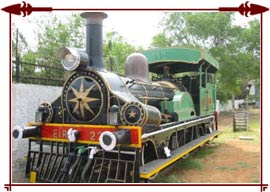 Trisha Gupta finds the grand old lady of Indian Railways can still set hearts aflutter.
Trisha Gupta finds the grand old lady of Indian Railways can still set hearts aflutter.In 1837, Victor Hugo wrote a mournful letter to a friend about how going anywhere by train made it impossible to actually see the countryside you were travelling through: “The flowers by the side of the road are no longer flowers but flecks, or rather streaks, of red and white; there are no longer any points, everything becomes a streak…”.
But we human beings are quick to adapt. By 1885, the steam-fuelled journey that Hugo found so impossibly fast had already become a certified way of looking at the landscape. Robert Louis Stevenson immortalized the experience of seeing the countryside unfurl as a succession of tableaux, in his ‘From a Railway Carriage’, a poem whose tempo perfectly reproduces the steady rhythm of the train itself:
“…Here is a child who clambers and scrambles,
All by himself and gathering brambles;
Here is a tramp who stands and gazes;
And here is the green for stringing the daisies!
Here is a cart runaway in the road
Lumping along with man and load;
And here is a mill, and there is a river:
Each a glimpse and gone forever!”
By the time I took the Fairy Queen from Delhi Cantonment to Alwar in 2002, this steam locomotive (of Hugo and Stevenson vintage) felt impossibly slow. But slowness, of course, was what I had come in search of. Standing out on the engine, next to the driver and his coal-shovelling assistants, I could see everything we passed with a clarity that no Rajdhani journey had ever provided: the vivid yellow of a girl’s odhni, the piles of onions being sorted by the roadside, even faces in the curious crowds that gathered to see our quaint contraption trundle by.
Built in 1855, the Queen was probably fast enough in the 50+ years she ran on the Howrah-Raniganj line of the Eastern Indian Railway. In 1971 she became the first exhibit of the National Rail Museum, in whose grassy environs she stayed happily parked until 1996, when she was dragged out of retirement and given a successful makeover by the Perambur workshop of the Southern Railway. The little green engine now tows a 60-seater passenger car on a seven-hour 143 km journey from Delhi to Alwar, every weekend from October to March. As the world’s oldest functioning locomotive (certified by the Guinness Book of World Records), the Queen is now “a living legend, much older than the Titanic”, which (gushes the website hopefully) “could attract visitors… like the Taj Mahal or Eiffel Tower”.
When she’s not chugging along devouring vast quantities of coal (250 kg per km), you can find the Queen back at the Rail Museum, where her now gleaming exterior seems almost out of place amidst the general air of 1970s torpor, the peeling black and white photos of Khrushchev’s visit to Chittaranjan. Then you read the faded orange sign that begins, “We must innovate. We must constantly improve. Today’s… powerful and sleek locomotives hurtle along the countryside faster than ever before…”. You can almost hear the Queen chuckle.
Published in Outlook Traveller magazine, October 2008
No comments:
Post a Comment